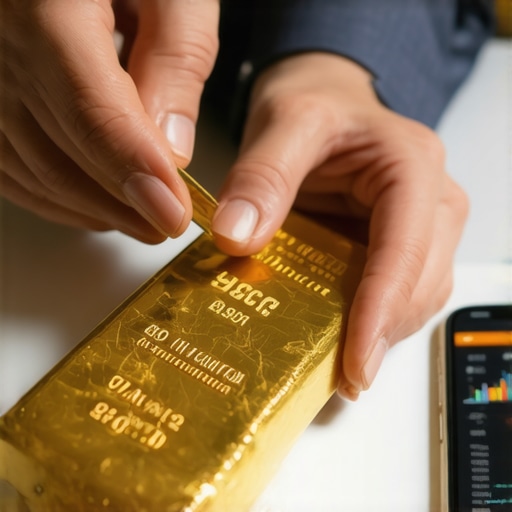Unlocking the Allure of Gold Coins: Your First Step Toward Secure Investing
In an era marked by economic uncertainty and fluctuating markets, investing in gold coins presents a timeless strategy for wealth preservation and growth. Unlike digital assets or volatile stocks, gold coins offer tangible value, historical significance, and a hedge against inflation. For beginners stepping into the gold investment arena in 2025, understanding the nuances of this precious metal’s market and the art of selecting the right coins is paramount. This guide distills expert insights and practical tips to help you embark confidently on your journey to investing in gold coins.
Discovering the Nuances: What Makes Gold Coins a Unique Investment?
Gold coins differ from bullion bars not just in form but in market dynamics and collectible value. Their intrinsic worth is influenced by purity, weight, mint origin, and rarity. For example, American Gold Eagles and Canadian Maple Leafs are popular for their liquidity and recognized authenticity worldwide. As an investor, prioritizing reputable mints ensures ease of resale and safeguards against counterfeit risks. Additionally, gold coins often carry a numismatic premium, which can enhance their value beyond the spot price of gold, especially for rare or limited editions.
Step-by-Step: How to Choose Your First Gold Coins Wisely
Begin by researching coin types that align with your investment goals—whether for long-term wealth preservation or potential appreciation. Focus on 22 to 24 karat coins to maximize purity. Verify the coin’s authenticity through certification from recognized authorities like the Professional Coin Grading Service (PCGS). Store your coins securely, preferably in a safe deposit box or a trusted vault service, to protect your physical asset from theft or damage.
How Can Beginners Navigate the Risks and Costs Associated with Gold Coin Investing?
New investors often wrestle with concerns about fluctuating premiums, storage costs, and liquidity. It’s crucial to buy from established dealers who provide transparent pricing, avoiding inflated markups. Be mindful of taxes applicable to precious metals in your jurisdiction and consider them in your cost calculations. While gold coins are relatively liquid, selling at the right time to avoid market dips can preserve your returns. Diversifying with a mix of bullion and collectible coins can balance risk and reward effectively.
Integrating Gold Coins into a Balanced Investment Portfolio
Gold coins are more than just collectibles; they function as a strategic hedge against economic downturns and inflationary pressures. Incorporating them alongside stocks, bonds, and other assets can enhance portfolio resilience. For a deeper dive into how gold complements other investment vehicles, explore insights on why gold is a hedge against inflation. This balanced approach helps mitigate risks and fosters long-term growth.
If you’re ready to explore more detailed strategies and safe buying tips, check out our comprehensive guide to buying gold coins for collection and investment.
Interested in sharing your gold investing experiences or questions? Join the conversation below!
Source: World Gold Council – a leading authority on gold investment trends and market analysis, providing invaluable data for investors worldwide.
Assessing Market Timing: When Is the Optimal Moment to Buy Gold Coins?
Market timing plays a pivotal role in enhancing returns from gold coin investments. While gold is often viewed as a store of value, its price fluctuates due to global economic factors, geopolitical tensions, and shifts in currency valuations. Savvy investors monitor these macroeconomic indicators and seasonality trends to identify entry points that optimize purchase costs. For instance, gold prices often dip during periods of strong US dollar performance or when equity markets rally aggressively. Understanding these cyclical patterns allows investors to capitalize on lower premiums and build positions before potential price appreciations.
Additionally, staying informed about central bank policies and inflation data can help anticipate shifts in gold demand. The International Monetary Fund (IMF) reports that rising inflationary pressures often prompt asset allocation adjustments favoring precious metals as a hedge, impacting coin prices accordingly. Combining technical chart analysis with fundamental economic insights creates a comprehensive framework for timing investments effectively.
What Advanced Metrics Should Experts Use to Evaluate Gold Coin Investment Potential?
Beyond purity and rarity, experts consider nuanced metrics such as the coin’s historical price volatility, liquidity in secondary markets, and the premium-to-spot price ratio. Tracking the volatility of specific gold coin types compared to bullion bars can reveal which coins provide more stable returns. Liquidity metrics focus on the ease of resale and the breadth of the buyer base—for example, American Gold Eagles tend to have higher liquidity than specialized numismatic coins.
Analyzing the premium-to-spot ratio over time highlights whether a coin is overvalued relative to the underlying gold content, guiding decisions on buying or holding. Incorporating these metrics with qualitative assessments, such as mint reputation and geopolitical factors influencing coin availability, supports a robust investment strategy.
Integrating Gold Coins with Other Precious Metal Investments
While gold coins serve as a cornerstone for tangible asset portfolios, diversifying into other precious metals like silver, platinum, and palladium can optimize risk-adjusted returns. Each metal responds differently to economic cycles and industrial demand, offering complementary investment dynamics. Investors should consider allocation percentages carefully, ensuring gold remains the primary inflation hedge while other metals provide growth and diversification benefits.
For those interested in expanding their precious metal holdings, exploring best physical gold investment options for wealth protection can provide guidance on balancing various asset types effectively within a portfolio.
Storage and Security: Beyond Basic Safeguarding
Protecting physical gold coins from theft, damage, or loss requires advanced storage strategies beyond simple safes or home security. Professional vault storage services offer insured, climate-controlled environments that preserve coin integrity and provide peace of mind. Additionally, investors should maintain detailed inventory records, including purchase documentation and certification details, to streamline insurance claims or resale processes.
Digital asset management tools have emerged to assist investors in tracking their precious metals portfolios, enabling real-time valuation updates and historical performance analysis. Embracing such technologies enhances transparency and informed decision-making.
Expanding Knowledge Through Trusted Resources
Continuous education is critical for mastering gold coin investment complexities. The World Gold Council remains a premier resource, offering comprehensive market research, demand trends, and investment insights that inform strategic decisions. Their data-driven reports provide valuable context on global gold supply and demand, influencing price forecasts and investment timing.
For investors aiming to deepen their understanding, we recommend exploring articles like Gold Demand Trends in Emerging Markets: What to Watch, which highlight evolving global consumption patterns that directly impact gold coin valuations.
Have you experimented with advanced gold coin investment strategies or integrated other precious metals into your portfolio? Share your experience in the comments below or pass this article along to fellow investors seeking expert insights!
Decoding Economic Indicators: Leveraging Macroeconomic Signals for Timely Gold Coin Investments
In the intricate dance of global finance, understanding the subtle interplay of economic indicators can significantly enhance your ability to time gold coin purchases. Beyond conventional wisdom, it’s essential to analyze leading indicators such as purchasing managers’ indices (PMI), real interest rates, and currency strength, which collectively forecast gold demand shifts. For instance, declining real interest rates often diminish the opportunity cost of holding non-yielding assets like gold coins, thereby stimulating investor interest and driving prices upward.
Moreover, geopolitical developments—ranging from trade tensions to regional conflicts—can trigger sudden surges in gold coin valuations due to their safe-haven appeal. Integrating these insights into your investment framework allows for preemptive positioning, capturing market inflections before they manifest in price adjustments.
How Does Inflation Expectations Impact Gold Coin Premiums Beyond Spot Price Movements?
Inflation expectations do not merely elevate the spot price of gold; they influence the premiums collectors and investors are willing to pay for specific gold coin issues. When inflationary pressures loom, demand intensifies not only for bullion but also for coins with numismatic significance, as they offer an additional layer of scarcity value. This phenomenon can cause premiums to expand disproportionately compared to the base gold price, especially for limited mintage or historically significant coins.
Conversely, in periods of stable or falling inflation expectations, premiums may contract as investor appetite shifts toward more liquid bullion forms. Therefore, advanced investors monitor inflation-linked bond yields (such as TIPS in the U.S.) and consumer price index (CPI) forecasts to anticipate these premium fluctuations and strategically select coin types accordingly.
Harnessing Data Analytics: Quantitative Tools for Precision in Gold Coin Portfolio Management
The advent of sophisticated data analytics has revolutionized precious metals investing, enabling the application of quantitative models to optimize gold coin portfolios. By employing time-series analysis and machine learning algorithms, investors can detect patterns in price movements, volatility clustering, and liquidity trends that traditional analysis might overlook.
For example, utilizing a moving average convergence divergence (MACD) indicator tailored for gold coin price indices can signal optimal entry and exit points, balancing risk and reward. Additionally, cluster analysis can segment coins by risk-return profiles, guiding diversification strategies that reduce unsystematic risk.
These methodologies complement fundamental assessments, marrying statistical rigor with market intuition to enhance decision-making precision.
Advanced Safeguarding: Integrating Blockchain Technology and Insurance Innovations for Gold Coin Security
Security concerns extend beyond physical protection; provenance verification and ownership transparency have become paramount. Blockchain-based registries are emerging as transformative tools, recording immutable transaction histories for gold coins and mitigating fraud risks. This digital ledger technology facilitates seamless ownership transfers while preserving privacy and ensuring authenticity.
Simultaneously, insurance providers have introduced parametric policies tailored for precious metals, offering rapid claim settlements triggered by predefined loss events, such as theft or environmental damage. These innovations, coupled with traditional vault storage, form a multi-layered defense framework safeguarding both the tangible and intangible value of gold coin investments.
Exploring Regulatory Landscapes: Impact of Taxation and Compliance on Gold Coin Investment Strategies
Understanding the evolving regulatory environment is crucial for minimizing tax liabilities and ensuring compliance. Jurisdictions differ markedly in capital gains treatment, value-added tax (VAT) applications, and reporting requirements for precious metals transactions. For instance, some countries exempt investment-grade gold coins from VAT, while others impose significant taxes that can erode returns.
Staying abreast of legislative changes and leveraging tax-advantaged accounts or trusts can optimize after-tax performance. Engaging with specialized tax advisors who comprehend the nuances of precious metals regulations ensures that your investment strategy aligns with both legal mandates and financial objectives.
Source: International Monetary Fund (IMF), “The Role of Gold in Financial Markets,” 2023 report, providing in-depth analysis of macroeconomic factors affecting gold demand and pricing dynamics.
Ready to elevate your gold coin investment approach with cutting-edge analytics and strategic insights? Dive deeper into advanced methodologies and safeguard your portfolio by subscribing to our expert newsletter today.
Decoding Macroeconomic Signals: Leveraging Economic Indicators for Smart Gold Coin Acquisitions
In the labyrinth of global financial markets, seasoned investors harness a spectrum of macroeconomic signals to optimize gold coin purchase timing. Key indicators such as purchasing managers’ indices (PMI), real interest rates, and currency valuations serve as early-warning systems, forecasting shifts in gold demand before they manifest in price changes. For instance, declining real interest rates reduce the opportunity cost of holding non-yielding assets like gold coins, typically invigorating investor demand and pushing prices upward.
Geopolitical tensions and trade disputes further amplify gold’s safe-haven appeal, precipitating abrupt spikes in coin valuations. Incorporating these multifaceted insights enables investors to anticipate market inflections, strategically positioning portfolios ahead of broader market movements.
How Does Inflation Expectation Influence Gold Coin Premiums Beyond the Spot Price?
Inflation expectations exert a nuanced influence on gold coin premiums that transcends mere spot price fluctuations. Elevated inflation forecasts often heighten demand not only for bullion but also for numismatic coins which embody scarcity and historical value. This elevated interest can cause premiums on select issues—especially limited mintage or historically significant coins—to swell disproportionately compared to the underlying gold value.
Conversely, during periods of subdued inflation expectations, premium compression tends to favor more liquid bullion forms. Advanced investors monitor instruments such as Treasury Inflation-Protected Securities (TIPS) yields and Consumer Price Index (CPI) projections to anticipate these shifts, enabling informed decisions on coin selection and timing.
Quantitative Analytics: Harnessing Data-Driven Models for Portfolio Optimization
The integration of sophisticated data analytics into gold coin investing has unlocked unprecedented precision in portfolio management. Techniques like time-series forecasting and machine learning algorithms illuminate hidden patterns in price volatility and liquidity dynamics that traditional analysis may overlook.
For example, applying a customized moving average convergence divergence (MACD) indicator to gold coin price indices can signal optimal buy or sell points, effectively balancing risk and reward. Cluster analysis further segments coins by volatility and liquidity profiles, guiding diversification strategies to mitigate unsystematic risk and enhance returns.
These quantitative tools, when coupled with expert qualitative assessments, forge a robust, evidence-based investment framework.
Innovative Security Measures: Blockchain Integration and Parametric Insurance in Gold Coin Protection
Protecting physical gold coins now transcends conventional safekeeping. Blockchain technology offers an immutable ledger for provenance verification and transaction transparency, significantly reducing fraud risk and enhancing ownership confidence. This decentralized record-keeping ensures seamless, secure transfers while maintaining privacy.
Complementing this technological advancement, insurance innovations such as parametric policies provide rapid claims processing triggered by predefined events like theft or environmental damage. Together with professional vault storage, these solutions construct a comprehensive security architecture safeguarding both the tangible and intangible value of your gold coin investments.
Navigating Regulatory Complexities: Tax Strategies and Compliance for Precious Metals Investors
Understanding and adapting to the evolving regulatory landscape is essential to maximize after-tax returns and maintain compliance. Tax treatments on capital gains, value-added tax (VAT), and reporting obligations vary widely across jurisdictions, potentially impacting investment profitability.
For instance, certain countries exempt investment-grade gold coins from VAT, while others impose significant levies that can erode margins. Employing tax-advantaged vehicles or trusts, and consulting specialized tax professionals familiar with precious metals regulations, can yield substantial benefits and mitigate risk.
Source: International Monetary Fund (IMF), “The Role of Gold in Financial Markets,” 2023 report, offering comprehensive analysis of macroeconomic forces shaping gold demand and pricing.
Ready to elevate your gold coin investment strategy with cutting-edge analytics and innovative security solutions? Subscribe to our expert newsletter for exclusive insights and advanced methodologies tailored for discerning investors.
Frequently Asked Questions (FAQ)
What are the key factors to consider when buying gold coins for investment?
Investors should evaluate purity (ideally 22 to 24 karats), coin weight, mint reputation, and certification authenticity. Numismatic value and liquidity also matter; coins from recognized mints like the American Gold Eagle typically have higher resale ease. Understanding premiums over spot price and storage costs is essential for informed decision-making.
How do inflation expectations affect the premiums on gold coins?
Inflation expectations influence not only the spot price of gold but also the premium investors pay for collectible coins. When inflation rises, demand for scarce or historically significant coins increases, driving premiums above the underlying gold value. Conversely, stable or falling inflation may reduce premiums, favoring more liquid bullion coins.
What are the risks associated with investing in gold coins, and how can they be mitigated?
Risks include market volatility, counterfeit coins, storage and insurance costs, and tax implications. Mitigation involves purchasing from reputable dealers, verifying authenticity via certifications, employing secure and insured storage solutions, understanding tax regulations, and diversifying within precious metals to balance risk.
How can advanced data analytics improve gold coin investment strategies?
Data analytics enable precise timing by analyzing price volatility, liquidity trends, and historical patterns using models like MACD and cluster analysis. These quantitative tools complement fundamental research, helping investors identify optimal entry and exit points and diversify portfolios to minimize unsystematic risk.
What role does blockchain technology play in securing gold coin investments?
Blockchain provides immutable provenance records and transparent ownership histories, significantly reducing fraud and counterfeiting risks. It enables secure, private, and seamless transfers, enhancing investor confidence and facilitating easier verification of authenticity in secondary markets.
How should gold coins be integrated with other precious metals in an investment portfolio?
Gold coins serve as a core inflation hedge, while metals like silver, platinum, and palladium offer diversification benefits due to their distinct industrial uses and market drivers. Allocating assets thoughtfully across these metals can optimize risk-adjusted returns and enhance overall portfolio resilience.
What are the best practices for storing and insuring physical gold coins?
Advanced storage involves professional vaults with climate control and insurance coverage. Maintaining detailed inventory records and certifications is crucial. Emerging solutions include parametric insurance policies for rapid claims and digital asset management tools that provide real-time portfolio tracking.
How do tax regulations impact gold coin investment returns?
Tax treatments vary widely by jurisdiction, affecting capital gains, VAT, and reporting obligations. Some countries exempt investment-grade gold coins from VAT, while others impose taxes that can reduce profitability. Utilizing tax-advantaged accounts and consulting specialized advisors helps optimize after-tax returns and ensures compliance.
When is the optimal time to buy gold coins?
Optimal timing involves monitoring macroeconomic indicators such as real interest rates, PMI, inflation data, and geopolitical tensions. Prices often dip during strong currency periods or equity rallies. Combining fundamental and technical analyses allows investors to anticipate market cycles and purchase at favorable prices.
Can beginners effectively invest in gold coins without prior experience?
Yes, beginners can succeed by educating themselves on coin types, purity standards, and market dynamics. Starting with widely recognized coins from reputable dealers, securing proper storage, and gradually incorporating advanced metrics and strategies as knowledge grows ensures a solid foundation for long-term success.
Trusted External Sources
- World Gold Council (www.gold.org): An authoritative body providing comprehensive data on gold demand, supply trends, and investment insights critical for understanding global gold markets.
- International Monetary Fund (IMF) – “The Role of Gold in Financial Markets” Report (2023): Offers in-depth macroeconomic analyses and forecasts that influence gold pricing and investor behavior worldwide.
- Professional Coin Grading Service (PCGS) (www.pcgs.com): The leading certification authority that verifies gold coin authenticity and grading, essential for investor confidence and market liquidity.
- BuyingGoldNow.com: Specialized platform offering practical guides and research on gold coin investment strategies, precious metal diversification, and market timing.
- U.S. Mint (www.usmint.gov): Provides official information on American Gold Eagle coins and other government-issued bullion, supporting informed purchasing decisions.
Conclusion
Investing in gold coins in 2025 remains a compelling strategy for wealth preservation and portfolio diversification amid economic volatility. By understanding the intricate factors influencing coin value—such as purity, mint reputation, numismatic premiums, and macroeconomic signals—investors can optimize timing and selection. Incorporating advanced analytics and innovative security measures like blockchain enhances decision-making precision and safeguards assets effectively. Furthermore, navigating regulatory landscapes and integrating gold coins thoughtfully within a diversified precious metals portfolio maximize long-term returns while mitigating risks. Whether a novice or seasoned investor, embracing these expert insights empowers confident, strategic gold coin investment, securing tangible wealth for the future. Share your experiences, ask questions, or explore our related expert content to deepen your mastery of gold coin investing today.










